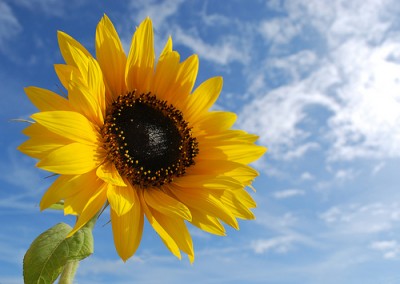
Image source: flickr
The most important concept in increasing the yield of a garden is planning. Start by splitting the growing season into three phases — early, middle, and late — then commit to keeping all areas planted in every phase. On the first day of winter, begin putting the plans to paper, finalizing the plans before starting seeds in mid-winter.
1. Natural Trellises
Corn and sunflowers are sturdy enough to hold most types of vining plants. A seed packet of each costs just a few dollars, making it the most economical alternative in vertical planting. Not only does trellising free space in the garden, but they can be planted closely together in rings, with one plant taking the center, rather than rows.
The cucurbits (squash, pumpkins, melons, cucumbers, etc.) can be seeded next to the sunflower. Sunflowers interact in a healthy way with their companions by repelling aphids. Hummingbirds are particularly attracted to sunflowers, and will eat white flies that are harmful to melons.
Morning glory is a beautiful vine to train on sunflowers. Try planting three sunflowers in a triangle pattern, and seed the surrounding area with morning glory for a stunning tower. Morning glory blooms for most of the growing season, attracting swarms of butterflies.
The Secrets Of Sea Minerals To Grow More “Nutritionally-Dense Food” Than You Can Possibly Eat!
Although some species have edible parts, do not consume morning glory unless you have positively identified the species. Even so, many edible species cause diarrhea, so it may be best to nix it from the menu.
Cut off the flower heads or remove the vine before they seed to avoid having a run-away problem with the vines.
Pole beans make a good companion to corn stalks. Because they are indeterminate, you will be able to harvest beans for several weeks in the year. They can also be planted mid-season, as early harvests of determinants free up space.
If you only have enough room to plant a few corn stalks, you can hand-pollinate the corn. When a tail of silky strands grows out of the ears of corn, they are ready for pollination. Cut off some of the tassels from the tops of the stalks, and carefully place into a paper bag. Shake the bag gently to loosen the pollen.
Story continues below video
Transfer the pollen from the bag to silks growing out of the ears with a paintbrush or small make-up brush. Instead of brushing the pollen onto the silks, hold the brush directly above the silks and tap gently to release the pollen. The process must be repeated daily for one week, gathering fresh pollen prior to each application.
2. Companion Plants
Although the same type of plant must be spaced properly to avoid crowing, most types do well when planted with companions. This technique maximizes the use of space, and often helps control weeds and insects.
Interspersing potatoes and beans in a given area takes advantage of growing space both above and below the ground. In combination, they also repel beetles. A stand of chives surrounding peas will repel aphids.
Aromatic herbs planted among widely spaced vegetables, like tomatoes, will help control weeds. They also mask the scent of vegetables, while attracting pollinators. Try mixing basil and oregano with tomatoes for a pizza garden, or cilantro and chives with tomatoes for a salsa garden.
3. Potato Boxes
Rather than growing potatoes across a patch, create a potato box to make the most use of space. Sow the potato eyes in a layer of soil in the box. When the leafy part is eight to 12 inches tall, spread another layer of eyes. Then, add the second layer of soil, being careful to allow the tops of the leaves from the first batch to remain exposed.
Repeat the process as many times as you are able during the growing season. Be certain to build the box with removable slats, so you can reach into the lower layers to harvest, throughout the season.
The techniques provided above are merely the basic. Get creative with your space, always be willing to try new things, and be certain to make an annual plan.
4. Conservation And Weed Control
By making early efforts to conserve moisture and soil, and control weeds, you get a leg up on maximizing yield. For the organic gardener, this means working the garden while the weather is still chilly. In northern areas, it means working before the last snowfall.
Over the winter, save up cardboard, or find a business that will allow you to take cardboard from its recycling bin. When the snow has melted, but the weather is not warm enough to germinate weeds, cover the garden with cardboard. Place your compost on top. If there is not enough compost, weigh the cardboard down with bricks or rocks.
The cover keeps weeds at bay, while retaining the winter moisture for as long as possible. When you’re ready to plant, punch holes in the cardboard large enough to accommodate your seeds or transplants.
What “tricks” do you use to increase garden yield? Tell us in the comments section below.
Sign up for Off The Grid News’ weekly email and get $600 worth of survival blueprints … free!
 Off The Grid News Better Ideas For Off The Grid Living
Off The Grid News Better Ideas For Off The Grid Living




